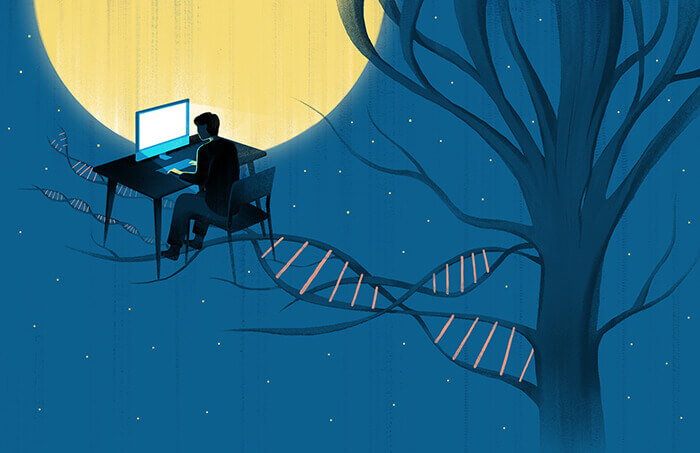



There are so many people who stay up later than 12:00 midnight and then have great difficulty waking up in the morning. This is because their internal clock is running at a slower rate and this in turn is genetically determined.
Scientists have gotten to the bottom of all this and found that a mutation in a gene termed CRY1 can slow the internal clock, distort the wake–sleep cycle, and contribute to delayed sleep phase disorder (DSPD).

People with DSPD often struggle to fall asleep at night, and sometimes they experience sleep that is not only delayed but fractured into a series of long naps. DSPD and other sleep disorders are associated with anxiety, depression, cardiovascular disease, and diabetes. People with DSPD also have trouble conforming to societal expectations and morning work schedules.
The connection between DSPD and the CRY1 gene variant was uncovered by scientists based at Rockefeller University. They detailed their findings April 6 in the journal Cell, in an article entitled “Mutation of the Human Circadian Clock Gene CRY1 in Familial Delayed Sleep Phase Disorder.”
“Here, we report a hereditary form of DSPD associated with a dominant coding variation in the core circadian clock gene CRY1, which creates a transcriptional inhibitor with enhanced affinity for circadian activator proteins Clock and Bmal1,” wrote the article’s authors. “This gain-of-function CRY1 variant causes reduced expression of key transcriptional targets and lengthens the period of circadian molecular rhythms, providing a mechanistic link to DSPD symptoms.”
Carriers of the gene variant experienced nighttime sleep delays of 2–2.5 hours compared to noncarriers. “Carriers of the mutation have longer days than the planet gives them, so they are essentially playing catch-up for their entire lives,” said the Cell paper’s first author Alina Patke, Ph.D., a research associate in the lab of principal investigator Michael Young, Ph.D., Richard and Jeanne Fisher Professor and head of the Laboratory of Genetics at The Rockefeller University.
Young’s lab has studied the circadian clock for more than three decades, identifying a number of the genes involved in keeping flies, humans, and other animals on schedule when it comes to eating and sleeping.
To find out whether mutations in any known circadian genes were linked to DSPD, Young and Patke collaborated with sleep researchers at Weill Cornell Medical College. Subjects were asked to spend 2 weeks in a laboratory apartment that was isolated from all cues to the time of day, eating and sleeping whenever they were inclined. Researchers also collected skin cells from each person.
Most people will follow a roughly 24-hour sleep–wake cycle when put in such a free-run environment. However, a DSPD subject that caught the researcher’s interest not only stayed up late, but had a cycle that was about 30 minutes longer. Moreover, changes in body temperature and hormones that cycle along with the circadian clock—including melatonin, which helps regulate sleep—were also delayed.
“Melatonin levels start to rise around 9 or 10 at night in most people,” noted Young. “In this DSPD patient, that doesn’t happen until 2 or 3 in the morning.”
When the researchers examined the DNA from the DSPD patient, one variant stood out—a mutation in CRY1, a gene that had already been implicated in the circadian cycle.
In a healthy circadian clock, a handful of genes turn on and off over a 24-hour cycle. The protein made by CRY1 is normally responsible for suppressing some of these genes during certain parts of the cycle. But Young and Patke discovered that the mutation identified in the patient made the CRY1 protein more active than usual, keeping other clock genes switched off for a longer period of time.
The researchers reached out to other members of the patient’s family and discovered five relatives who shared the mutation in CRY1. All of them had signs of DSPD, or a history of persistent sleep problems, too.
Then, Young’s team turned to large genetic databases from around the world to determine the prevalence of CRY1 mutations. With a collaborator in Turkey, they first identified many unrelated families and dozens of Turkish people with the CRY1 mutation. After contacting them and administering interviews and questionnaires, the researchers were able to confirm that 38 people with the mutation had altered sleep behavior, while none of their relatives without the CRY1 mutation had unusual sleep patterns.
Finally, after scouring larger genetic databases for CRY1 mutations, Young’s group calculated that as many as one in 75 people of non-Finnish European descent have at least one copy of the DSPD mutation. The mutation is dominant, which means that having just one copy of it can cause a sleep disorder.
The researchers say that right now there’s no established benefit for DSPD patients in being tested for the CRY1 mutation.
“Just finding the cause doesn’t immediately fix the problem,” says Patke. “But it’s not inconceivable that one might develop drugs in the future based on this mechanism.”
For now, many DSPD patients are able to control their sleep cycles—and get to bed earlier than their body wants—by following strict schedules.
“It’s a bit like cigarette smoking in that there are things we can do to help the problem before turning to drugs,” explained Young. Some patients seem to be helped by getting strong light exposure during the day, he adds.
The team already has future studies planned to work out whether CRY1 mutations also affect the metabolic cycles of people with DSPD, since the human circadian cycle is known to not only regulate sleep, but also hunger and levels of metabolites and hormones.
 Relevant
news
Relevant
news